Modeling Requirements for Collaborative Robotic Services
Abstract
:1. Introduction
2. Requirements for Modeling Collaborative Robots
- coexistence—when a robot and a human are in the same physical space but do not overlap each other’s workspace;
- interaction—when a human and a robot share the same workspace and communicate with each other, but the human and the robot work on the same task stepwise, in sequential order;
- cooperation—developed among human and robot agents who have their autonomy, expressed in terms of goals, objectives, utility or profit,
- collaboration—when there is a joint activity of humans and robots in a shared workspace to accomplish a set of given working tasks cooperatively.
2.1. The Requirements Cycle in the Design of Collaborative Automated Systems
- 1.
- Prolog: Contains a sequence of processing instructions and/or document type declaration. It can be divided into two parts:
- A KML declaration defines the KML version, the encoding type, and if it is an independent document (<?kml version="1.0" encoding="ISO-8859-1"?>) (https://www.w3schools.com/charsets/ref_html_8859.asp (accessed on 3 November 2023)).
- The document type declaration defines the type of the document. (Optional).
- 2.
- Body: The document information organized as a single tree of marked elements.
2.2. The Goal-Oriented Service Approach
- (i)
- Using goal-oriented modeling is suitable to describe a service network architecture involving the interaction with different automation systems and collaborative robots.
- (ii)
- The method focuses on all service interactions, especially the human-robot relation, responsible for the value co-creation.
- (iii)
- The proposal revises KAOS diagrams to improve service network requirements and design.
- (iv)
- We developed an algorithm to transfer KAOS diagrams to KML, which can automate documentation, support reusability, and fit the requirements cycle described in Figure 1.
- (v)
- We developed an algorithm to transfer KML to PNML to get a formal model for verification. The formal model verifies the intended behavior, as well as its structure.
3. A Case Study of Collaborative Robots in a Hospital Environment
3.1. The System-As-Is
3.2. The System-to-Be: Introducing Human–Robot Collaboration
- (i)
- A pre-plan requesting the robot to move from its current position to the point where it should get some item to deliver.
- (ii)
- The plan, fitting classic AI definition, where the robot follows the trajectory between the pickup and delivery point, avoiding obstacles and managing emerging occurrences (such as being out of power). The routing system is embedded in the robot control and is not part of the value creation.
- (iii)
- The post-plan, regarding the plan mentioned above, analyzes its impact on the hospital workflow and logistics.
- (i)
- Identify and separate services (Autonomous Mobile Robot—AMR, Supervisor control system, and Automatic Medication Dispenser) to focus on service-oriented network architecture.
- (ii)
- Collapse functionalities, actions, rules, and conditions into targets (including possible non-functional requirements). Objectives represent goals identified in the user-supplier interaction and must be satisfied by the robot collaborative missions orchestrated by the Hospital Logistic System.
- (iii)
- Identifies the essential communication between the logistic services and the agents responsible for issuing and receiving goods. In other words, it allows us to attribute/responsabilize each identified requirement to an agent. It is essential to mention that the lowest level of refinement reaches a stage where all actions match one or more agents (the responsibility diagram).
3.3. Modeling the Human–Robot Interaction
4. Conclusions
Author Contributions
Funding
Institutional Review Board Statement
Informed Consent Statement
Data Availability Statement
Acknowledgments
Conflicts of Interest
References
- Vicentini, F. Collaborative Robotics: A Survey. J. Mech. Des. 2021, 143, 040802. [Google Scholar] [CrossRef]
- Francesco, P.; Paolo, G.G. AURA: An Example of Collaborative Robot for Automotive and General Industry Applications. Procedia Manuf. 2017, 11, 338–345. [Google Scholar] [CrossRef]
- Proia, S.; Carli, R.; Cavone, G.; Dotoli, M. A Literature Review on Control Techniques for Collaborative Robotics in Industrial Applications. In Proceedings of the 2021 IEEE 17th International Conference on Automation Science and Engineering (CASE), Lyon, France, 23–27 August 2021; pp. 591–596. [Google Scholar] [CrossRef]
- Silva, J.R.; Macedo, E.C.T.; Correa, Y.G.; Medeiros, R.P. A Multilayer Proposal to a Smart Home Applied to Healthcare. Polytechnica 2021, 4, 1–14. [Google Scholar] [CrossRef]
- Cabello, R.; Escalona, M.J.; Enríquez, J.G. Beyond the Hype: RPA Horizon for Robot-Human Interaction. In Lecture Notes in Business Information Processing; Springer: Cham, Switzerland, 2020; Volume 393, pp. 185–199. [Google Scholar] [CrossRef]
- Cabello Ruiz, R.; Jiménez Ramírez, A.; Escalona Cuaresma, M.J.; González Enríquez, J. Hybridizing humans and robots: An RPA horizon envisaged from the trenches. Comput. Ind. 2022, 138, 103615. [Google Scholar] [CrossRef]
- Maurice, P.; Schlehuber, P.; Padois, V.; Measson, Y.; Bidaud, P. Automatic selection of ergonomie indicators for the design of collaborative robots: A virtual-human in the loop approach. In Proceedings of the 2014 IEEE-RAS International Conference on Humanoid Robots, Madrid, Spain, 18–20 November 2014. [Google Scholar] [CrossRef]
- Maurice, P.; Padois, V.; Measson, Y.; Bidaud, P. Human-oriented design of collaborative robots. Int. J. Ind. Ergon. 2017, 57, 88–102. [Google Scholar] [CrossRef]
- Gualtieri, L.; Rauch, E.; Vidoni, R. Emerging research fields in safety and ergonomics in industrial collaborative robotics: A systematic literature review. Robot. Comput. Integr. Manuf. 2021, 67, 101998. [Google Scholar] [CrossRef]
- Shaumburg, H.; Korablev, V.; Laszlo, U. Technological Transformation: A New Role for Human, Machines and Management; Springer International Publishing: Cham, Switzerland, 2020; Volume 157. [Google Scholar] [CrossRef]
- Saenz, J.; Elkmann, N.; Gibaru, O.; Neto, P. Survey of methods for design of collaborative robotics applications—Why safety is a barrier to more widespread robotics uptake. In Proceedings of the 2018 4th International Conference on Mechatronics and Robotics Engineering, Valenciennes, France, 7–11 February 2018; pp. 95–101. [Google Scholar] [CrossRef]
- Lv, Z.; Qiao, L. Deep belief network and linear perceptron based cognitive computing for collaborative robots. Appl. Soft Comput. J. 2020, 92, 106300. [Google Scholar] [CrossRef]
- Qiu, R. Service Science; John Wiley & Sons: Hoboken, NJ, USA, 2014. [Google Scholar]
- Čaić, M.; Odekerken-Schröder, G.; Mahr, D. Service robots: Value co-creation and co-destruction in elderly care networks. J. Serv. Manag. 2018, 29, 178–205. [Google Scholar] [CrossRef]
- Silva, J.R.; Silva, J.M.; Vaquero, T.S. Formal Knowledge Engineering for Planning: Pre and Post-Design Analysis. In Knowledge Engineering Tools and Techniques for AI Planning; Vallati, M., Kitchin, D.E., Eds.; Springer: Berlin/Heidelberg, Germany, 2020; pp. 47–66. [Google Scholar]
- Horkoff, J.; Aydemir, F.B.; Cardoso, E.; Li, T.; Maté, A.; Paja, E.; Salnitri, M.; Piras, L.; Mylopoulos, J.; Giorgini, P. Goal-oriented requirements engineering: An extended systematic mapping study. Requir. Eng. 2019, 24, 133–160. [Google Scholar] [CrossRef] [PubMed]
- Wang, L.; Gao, R.; Váncza, J.; Krüger, J.; Wang, X.V.; Makris, S.; Chryssolouris, G. Symbiotic human-robot collaborative assembly. Cirp Ann. 2019, 68, 701–726. [Google Scholar] [CrossRef]
- Lasota, P.A.; Fong, T.; Shah, J.A. A Survey of Methods for Safe Human-Robot Interaction. Found. Trends Robot. 2017, 5, 261–349. [Google Scholar] [CrossRef]
- Kiani, F.; Seyyedabasi, A.; Nematzadeh, S.; Candan, F.; Çevic, T.; Anka, F.A.; Randazzo, G.; Lanza, S.; Muzirafuti, A. Adaptive Metaheuristic-Based Methods for Autonomous Robot Path Planning: Sustainable Agricultural Applications. Appl. Sci. 2022, 12, 943. [Google Scholar] [CrossRef]
- Tuba, E.; Strumberger, I.; Zivkovic, D.; Bacannin, N.; Tuba, M. Mobile Robot Path Planning by Improved Brain Storm Optimization Algorithm. In Proceedings of the 2018 IEEE Congress on Evolutionary Computation (CEC), Rio de Janeiro, Brazil, 8–13 July 2018; pp. 1–8. [Google Scholar] [CrossRef]
- Cherubini, A.; Navarro-Alarcon, D. Sensor-Based Control for Collaborative Robots: Fundamentals, Challenges, and Opportunities. Front. Neurorobotics 2021, 14, 576846. [Google Scholar] [CrossRef] [PubMed]
- Albuquerque, D.; Castro, J.; Souza, A. A Requirement Definition Framework for Robotic Systems Domain: An exploratory study. In Proceedings of the Workshop in Requirements Engineering, Rio de Janeiro, Brazil, 5–6 September 2018. [Google Scholar]
- Zhen, L.; Li, R.; Liu, X.; Chen, Y. A New Practical Robust Control Design for Model-based Uncertain Collaborative Robot. In Proceedings of the 2023 International Conference on Advanced Robotics and Mechatronics, (ICARM), Sanya, China, 8–10 July 2023; pp. 768–773. [Google Scholar] [CrossRef]
- van Lamsweerde, A.; Darimong, R.; Letier, E. Managing conflicts in goal-driven requirements engineering. IEEE Trans. Softw. Eng. 1998, 24, 908–926. [Google Scholar] [CrossRef]
- Cloutier, R.J.; Hutchison, N. SeBok: Guide to the Systems Engineering Body of Knowledge, 2nd ed.; INCOSE: San Diego, CA, USA, 2022. [Google Scholar]
- Liu, Z.; Ming, X.; Song, W.; Qiu, S.; Qu, Y. A perspective on value co-creation-oriented framework for smart product-service system. Procedia CIRP 2018, 73, 155–160. [Google Scholar] [CrossRef]
- Proper, H.A.; Bjeković, M.; Feltus, C.; Razo-Zapata, I. On the development of a modelling framework for value co-creation. CEUR Workshop Proc. 2018, 2239, 122–132. [Google Scholar]
- van Lamsweerde, A. Goal-oriented requirements engineering: A guided tour. In Proceedings of the 5th IEEE International Symposium in Requirements Engineering, Toronto, ON, Canada, 27–31 August 2001; pp. 249–263. [Google Scholar]
- Basile, F.; Chiacchio, P.; Del Grosso, D. Modelling automation systems by UML and Petri Nets. In Proceedings of the 2018 9th International Workshop on Discrete Event Systems, Gothenburg, Sweden, 28–30 May 2008; pp. 308–313. [Google Scholar] [CrossRef]
- Zhang, H.-X.; Zhu, L.-Z. Building Dynamic Model in UML Using Colored Petri Nets. In Proceedings of the 2009 International Symposium on Computer Network and Multimedia Technology, Wuhan, China, 18–20 January 2009; pp. 1–4. [Google Scholar] [CrossRef]
- Silva, J.R.; Vital, E. Towards a Formal Design to Service-Oriented Cloud Manufacturing. In Proceedings of the Congresso Brasileiro de Automática; Bernardon, D.P., Vargas, F.L., Eds.; Blucher: Santa Maria, Brazil, 2020; pp. 8–16. [Google Scholar]
- Kindler, E. The Petri Net Markup Language and ISO/IEC 15909-2: Concepts, Status, and Future Directions. In Design of Complex Automation Systems; Schnieder, E., Ed.; ifak—Institut für Automation und Kommunikation: Braunschweig, Germany, 2006; pp. 35–55. [Google Scholar]
- Orellana, M.A.; Silva, J.R.; Pellini, E.L. A model-based and goal-oriented approach for the conceptual design of smart grid services. Machines 2021, 9, 12. [Google Scholar] [CrossRef]
- Roy, R.B.; Lillrank, P.; Sreekanth, V.K.; Torkki, P. Designing Service Machines; Springer: Singapore, 2019. [Google Scholar] [CrossRef]
- Silva, M. 50 years after the PhD thesis of Carl Adam Petri: A perspective. Ifac Proc. Vol. 2012, 45, 13–20. [Google Scholar] [CrossRef]

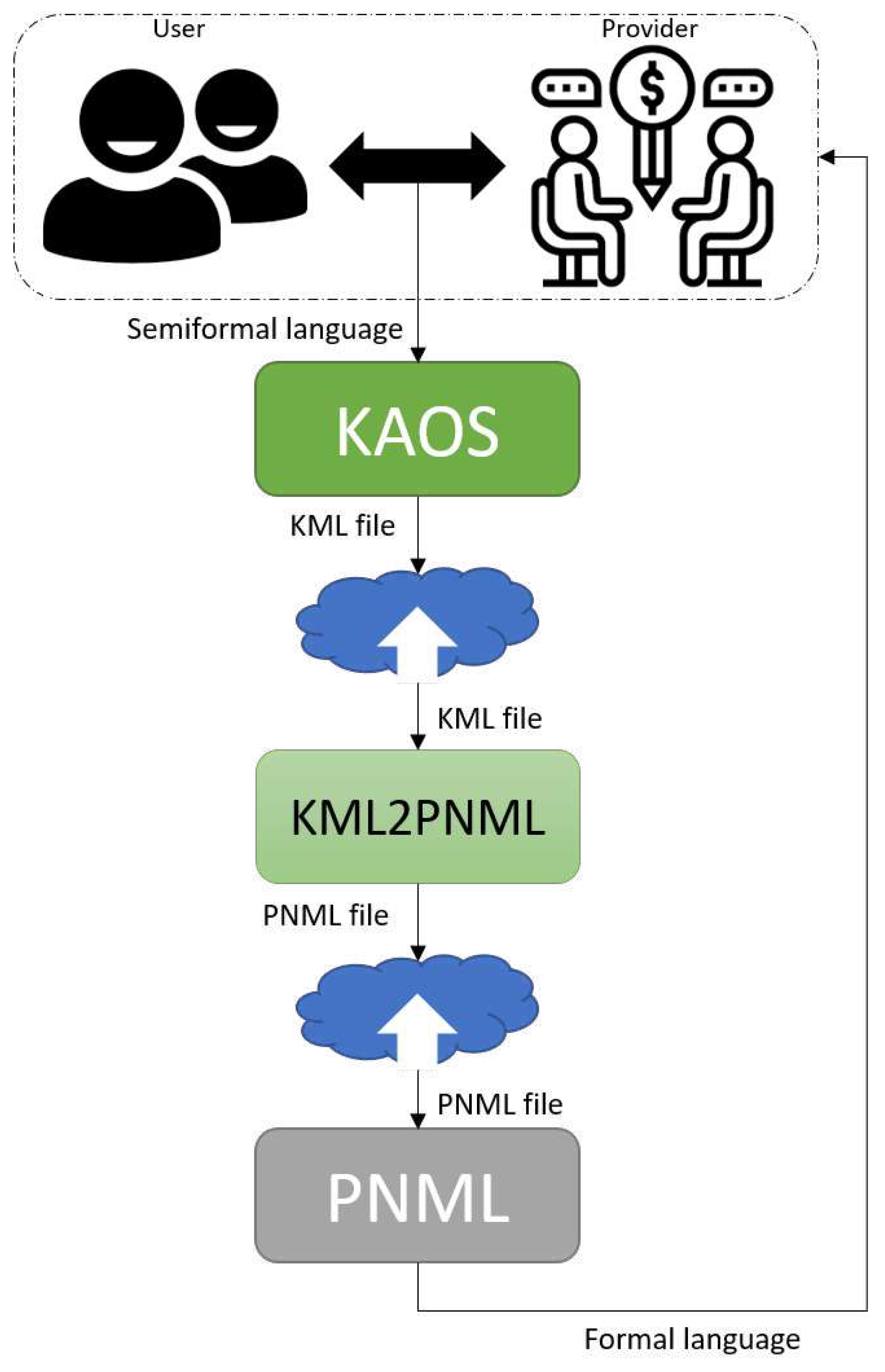
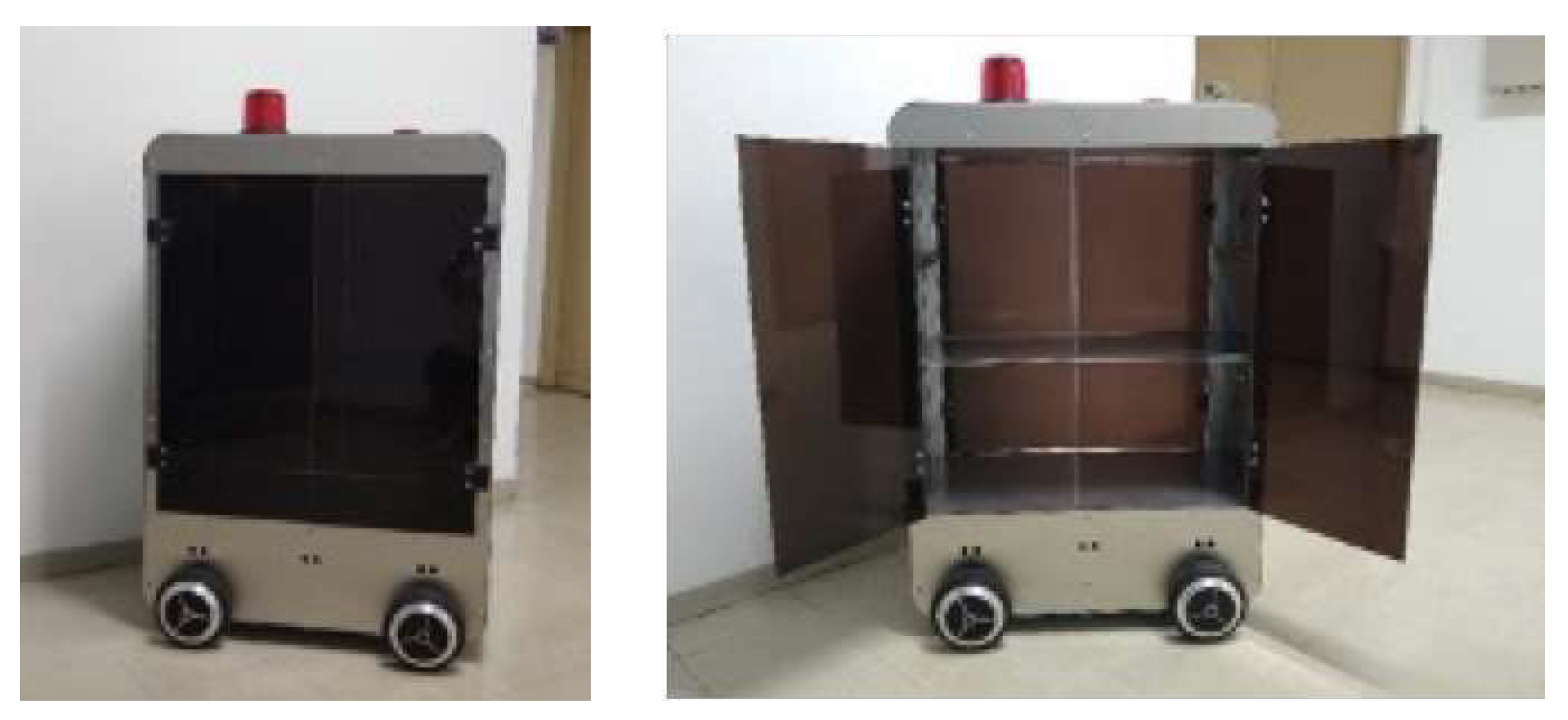
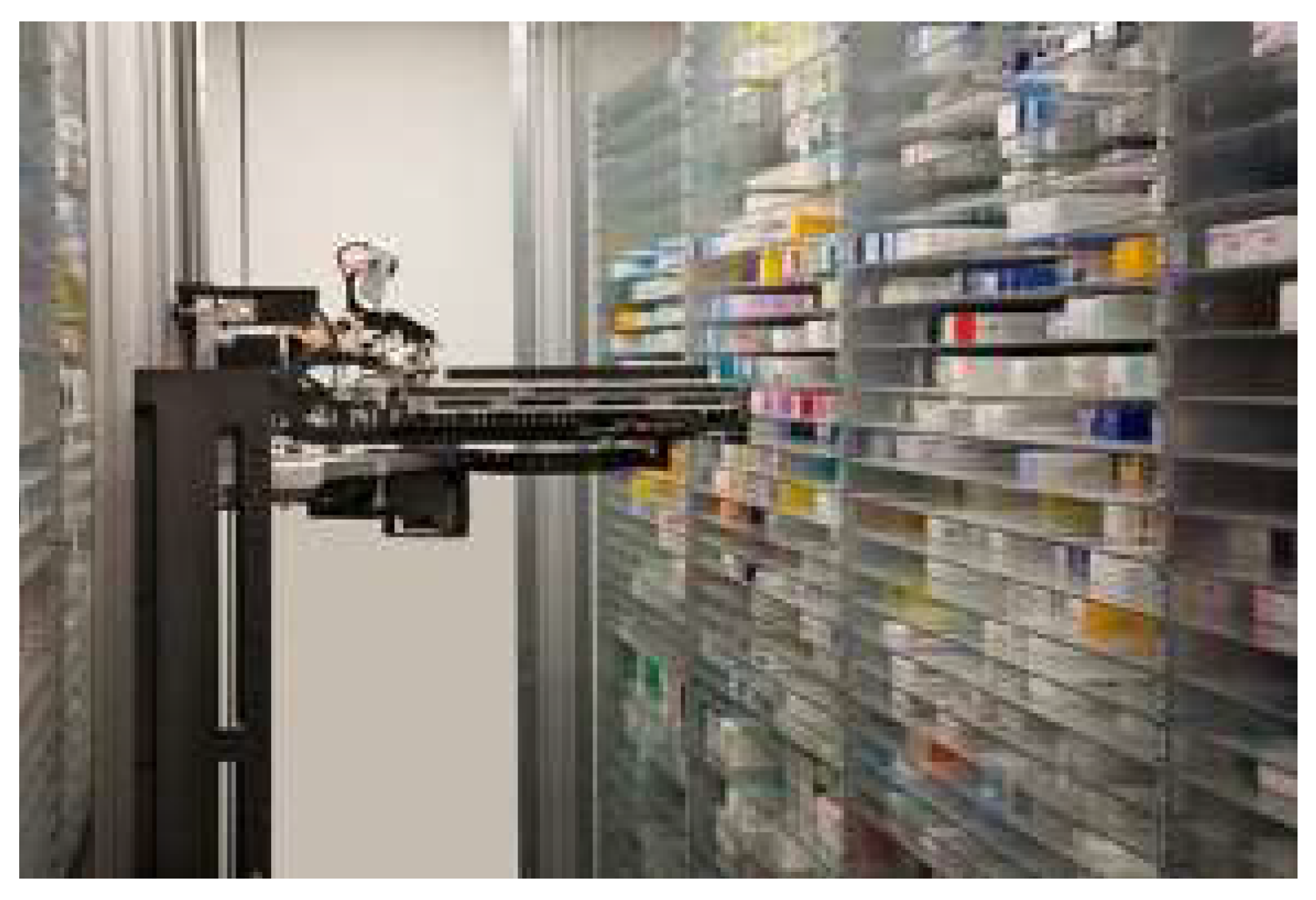
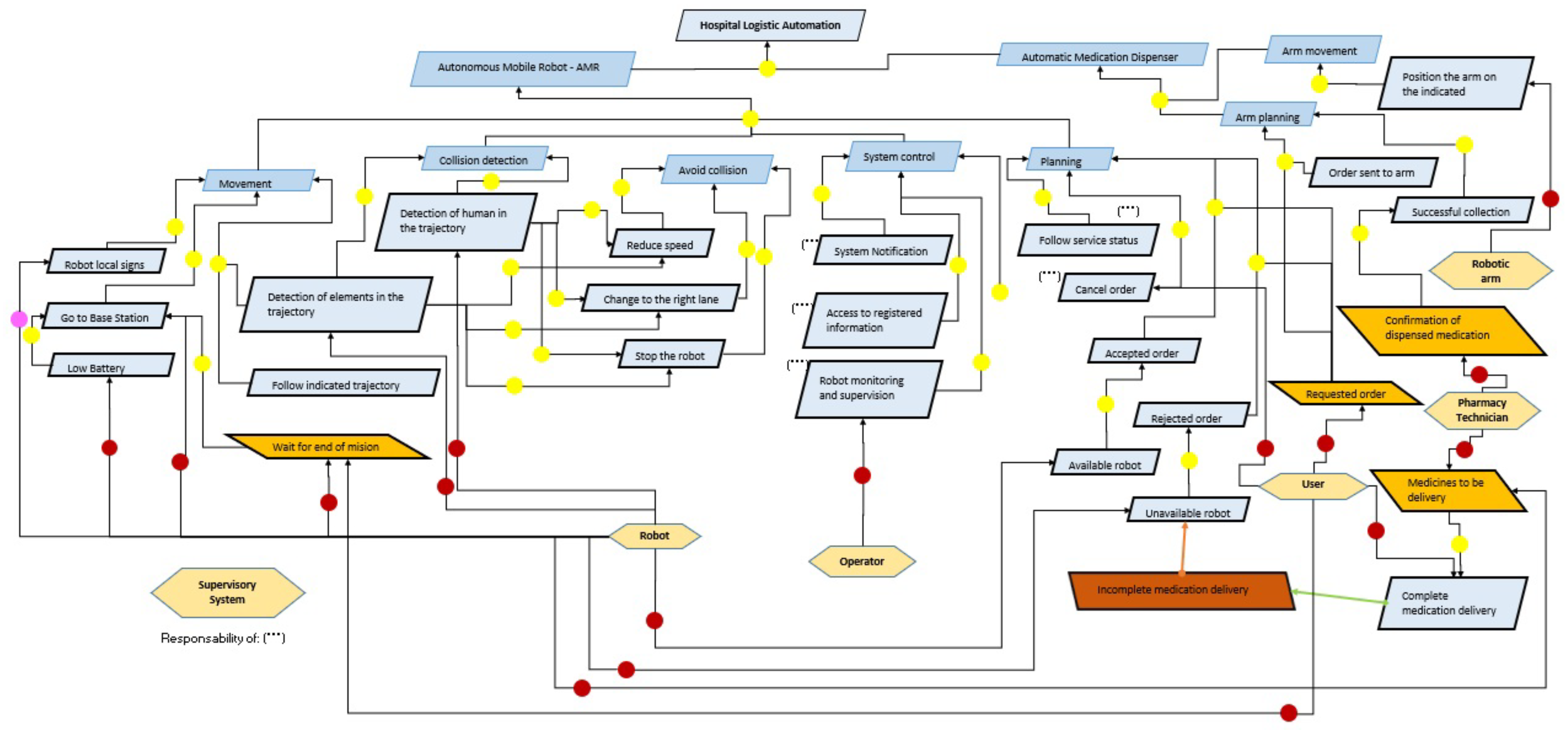
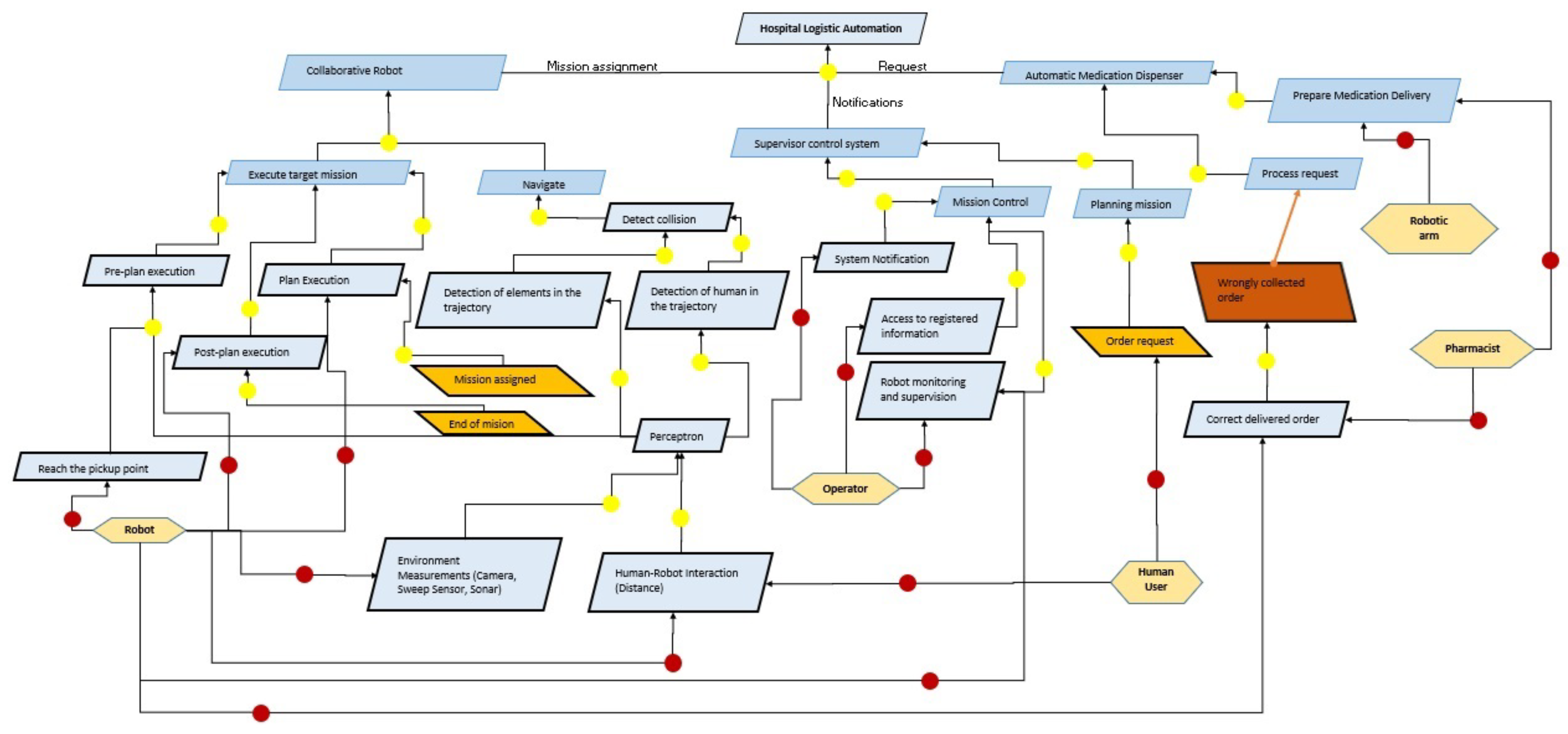

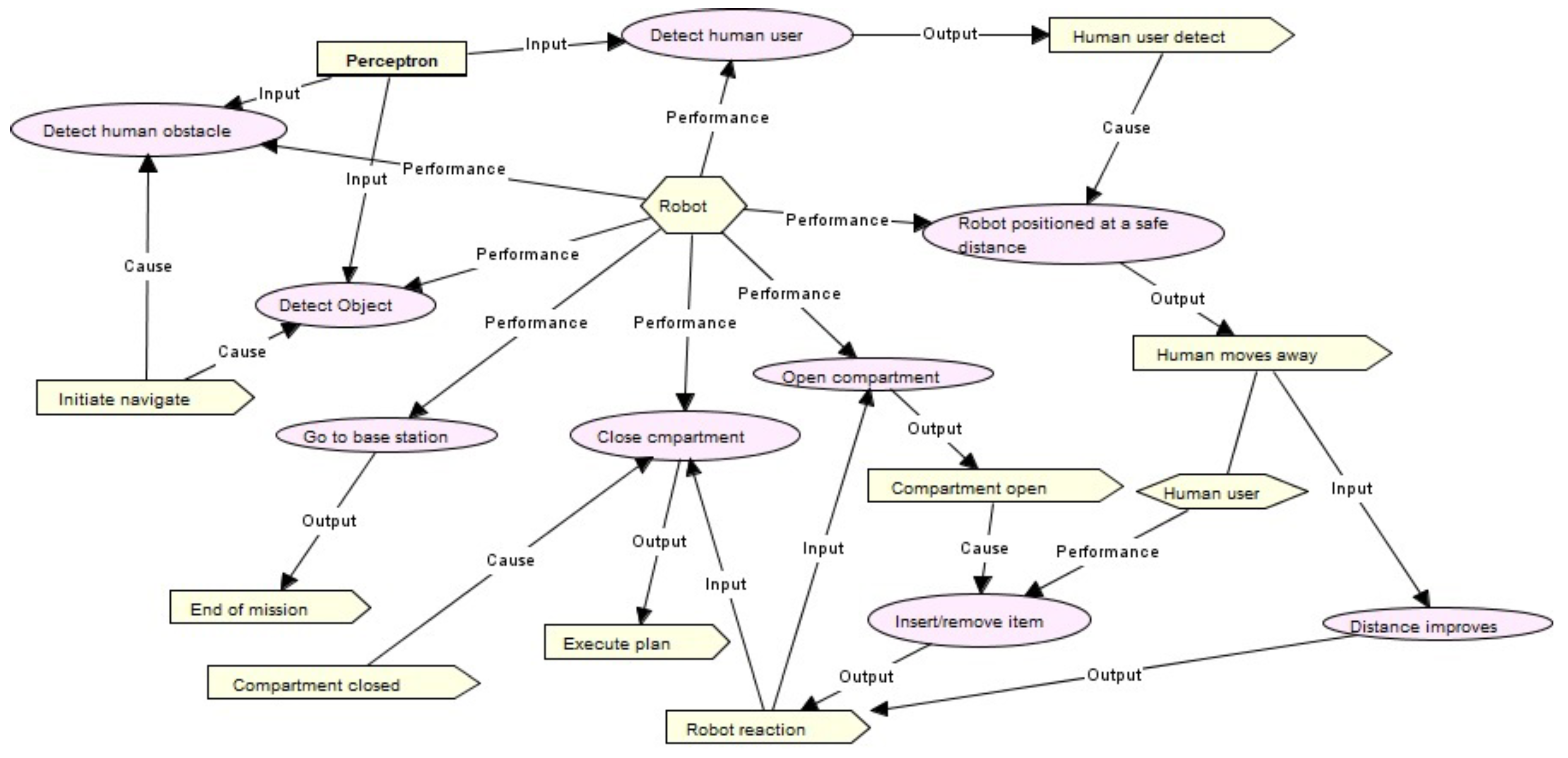
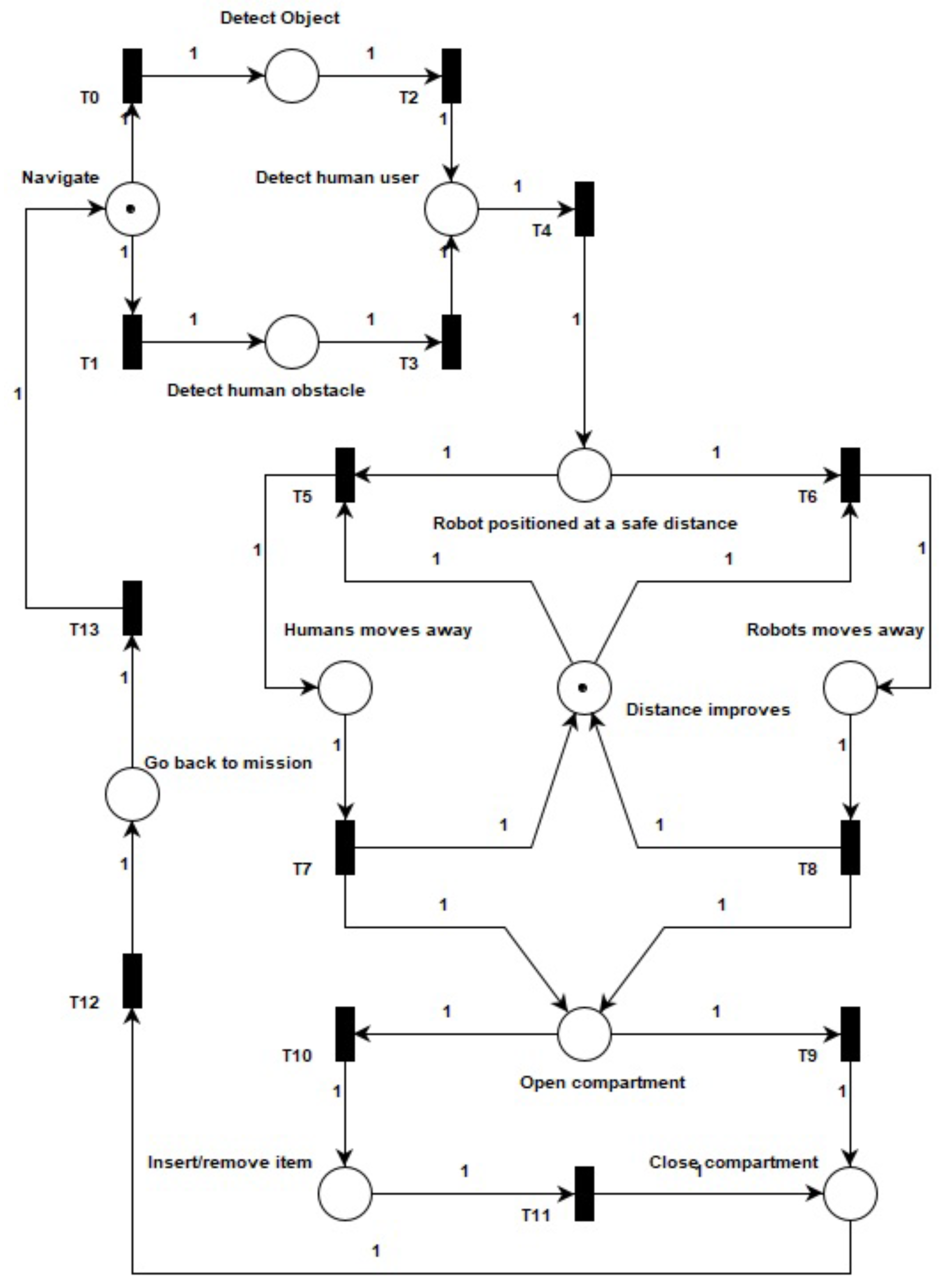
| KAOS Elements | Elements Description | KML Standard Code |
|---|---|---|
 | Describes an objective to be achieved by the system or one of the subsystems. Special tags are printed blue. | <Id>...</Id> Identifier of element <Name>....</Name> Name of the element <Type>....</Type> Diagram elements type: Goals |
 | A low-level objective with clear satisfaction criteria can be used in test routines. Satisfaction of the requirements should be reflected (using the objectives diagram) in the justification of other objectives related to these requirements. | <Id>...</Id> Identifier of element <Name>....</Name> Name of the element <Type>....</Type> Diagram elements type: Requirement |
 | An unfavorable condition or constraint to the satisfaction of goals, usually originating in the context or domain of the overall goal. | <Id>...</Id> Identifier of element <Name>....</Name> Name of the element <Type>....</Type> Diagram elements type: Obstacle |
 | Used to designate the existence of a conflict between objectives or an object that prevents the satisfaction of the objective. | <ConflictTo>.... </ConflictTo> |
 | Denote results expected by the agents. It does not have clear criteria for satisfaction. Therefore, their satisfaction, partially defined, does not affect the satisfaction of the associated requirements. However, satisfaction of expectations can influence the satisfaction of agents, which is important if they are part of the coupling of services. | <Id>...</Id> Identifier of element <Name>....</Name> Name of the element <Type>....</Type> Diagram elements type: Expectation |
 | Denote systems external to the system under consideration that may be collaborative or supportive. In the case of support systems, they can be associated with invariants or with a hypothesis, in the case of the collaborative system (an external objective to be satisfied), and in this case, it must contribute to the global objective of the system being modeled. | <Id>...</Id> Identifier of element <Name>....</Name> Name of the element <Type>....</Type> Diagram elements type: Domain |
 | Active physical objects (system agents), humans, machines, or logical objects (software agents), are capable of performing operations that eventually change the state of the system. | <Id>...</Id> Identifier of element <Name>....</Name> Name of the element <Type>....</Type> Diagram elements type: Agent |
 | Represent passive and independent objects. Passive objects cannot perform operations; and are independent if they follow the object-oriented model with “behavioral completeness”. Its attributes, whose admissible values must be specified, define the state of the system. | <Id>...</Id> Identifier of element <Name>....</Name> Name of the element <Type>....</Type> Diagram elements type: Entity |
 | Use it to start or stop operations. They can be external or produced by operations (they become the output of the operation). | <Id>...</Id> Identifier of element <Name>....</Name> Name of the element <Type>....</Type> Diagram elements type: Event |
 | Used to connect (responsibility) to the responsible agent for requirements or expectations. | <ResponsabilityOf>.... </ResponsabilityOf> |
 | Used by different agents to enforce requirements. The operations can create objects, trigger state transitions, and activate another series of operations by calling another event or operation. | <Id>...</Id> Identifier of element <Name>....</Name> Name of the element <Type>....</Type> Diagram elements type: Operation |
 | Collector node used to connect objective with its sub-goals. Each connection contributes to the satisfaction of the objective in an inclusive way (AND node). Conventionally, if there is a partial order between the sub-goals, it should be represented from left to right. Alternative connections (OR nodes) will be represented by independent connectors. | <ToRefineAnd>.... </ToRefineAnd> or <ToRefineOr>.... </ToRefineOr> |
 | Collector node used to connect the agent with the goals, expectations, or requirements for which this agent is responsible. The same convention applies to inclusive and alternative connections. | <AssignedTo>.... </AssignedTo> |
 | Used to connect the operations with requirements (A requirement is said to be “closed” when this triangular Responsibility-Operationalization-Performance relationship has been established ) | <OperationalizationOf>.... </OperationaizationOf> |
Disclaimer/Publisher’s Note: The statements, opinions and data contained in all publications are solely those of the individual author(s) and contributor(s) and not of MDPI and/or the editor(s). MDPI and/or the editor(s) disclaim responsibility for any injury to people or property resulting from any ideas, methods, instructions or products referred to in the content. |
© 2023 by the authors. Licensee MDPI, Basel, Switzerland. This article is an open access article distributed under the terms and conditions of the Creative Commons Attribution (CC BY) license (https://creativecommons.org/licenses/by/4.0/).
Share and Cite
Zapata, O.S.M.; Correa, Y.G.; Yoshioka, L.R.; Silva, J.R. Modeling Requirements for Collaborative Robotic Services. Eng 2023, 4, 2941-2959. https://doi.org/10.3390/eng4040165
Zapata OSM, Correa YG, Yoshioka LR, Silva JR. Modeling Requirements for Collaborative Robotic Services. Eng. 2023; 4(4):2941-2959. https://doi.org/10.3390/eng4040165
Chicago/Turabian StyleZapata, Oscar Stiven Morales, Yaney Gomez Correa, Leopoldo Rideki Yoshioka, and Jose Reinaldo Silva. 2023. "Modeling Requirements for Collaborative Robotic Services" Eng 4, no. 4: 2941-2959. https://doi.org/10.3390/eng4040165
APA StyleZapata, O. S. M., Correa, Y. G., Yoshioka, L. R., & Silva, J. R. (2023). Modeling Requirements for Collaborative Robotic Services. Eng, 4(4), 2941-2959. https://doi.org/10.3390/eng4040165







